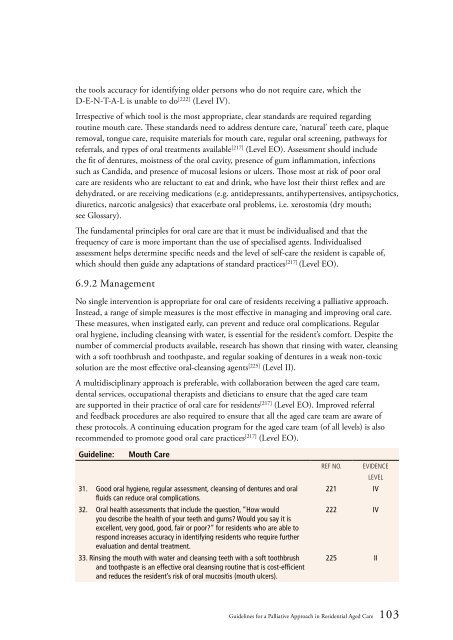Guidelines for a Palliative Approach in Residential Aged Care
Guidelines for a Palliative Approach in Residential Aged Care
Guidelines for a Palliative Approach in Residential Aged Care
You also want an ePaper? Increase the reach of your titles
YUMPU automatically turns print PDFs into web optimized ePapers that Google loves.
the tools accuracy <strong>for</strong> identify<strong>in</strong>g older persons who do not require care, which the<br />
D-E-N-T-A-L is unable to do [222] (Level IV).<br />
Irrespective of which tool is the most appropriate, clear standards are required regard<strong>in</strong>g<br />
rout<strong>in</strong>e mouth care. These standards need to address denture care, ‘natural’ teeth care, plaque<br />
removal, tongue care, requisite materials <strong>for</strong> mouth care, regular oral screen<strong>in</strong>g, pathways <strong>for</strong><br />
referrals, and types of oral treatments available [217] (Level EO). Assessment should <strong>in</strong>clude<br />
the fit of dentures, moistness of the oral cavity, presence of gum <strong>in</strong>flammation, <strong>in</strong>fections<br />
such as Candida, and presence of mucosal lesions or ulcers. Those most at risk of poor oral<br />
care are residents who are reluctant to eat and dr<strong>in</strong>k, who have lost their thirst reflex and are<br />
dehydrated, or are receiv<strong>in</strong>g medications (e.g. antidepressants, antihypertensives, antipsychotics,<br />
diuretics, narcotic analgesics) that exacerbate oral problems, i.e. xerostomia (dry mouth;<br />
see Glossary).<br />
The fundamental pr<strong>in</strong>ciples <strong>for</strong> oral care are that it must be <strong>in</strong>dividualised and that the<br />
frequency of care is more important than the use of specialised agents. Individualised<br />
assessment helps determ<strong>in</strong>e specific needs and the level of self-care the resident is capable of,<br />
which should then guide any adaptations of standard practices [217] (Level EO).<br />
6.9.2 Management<br />
No s<strong>in</strong>gle <strong>in</strong>tervention is appropriate <strong>for</strong> oral care of residents receiv<strong>in</strong>g a palliative approach.<br />
Instead, a range of simple measures is the most effective <strong>in</strong> manag<strong>in</strong>g and improv<strong>in</strong>g oral care.<br />
These measures, when <strong>in</strong>stigated early, can prevent and reduce oral complications. Regular<br />
oral hygiene, <strong>in</strong>clud<strong>in</strong>g cleans<strong>in</strong>g with water, is essential <strong>for</strong> the resident’s com<strong>for</strong>t. Despite the<br />
number of commercial products available, research has shown that r<strong>in</strong>s<strong>in</strong>g with water, cleans<strong>in</strong>g<br />
with a soft toothbrush and toothpaste, and regular soak<strong>in</strong>g of dentures <strong>in</strong> a weak non-toxic<br />
solution are the most effective oral-cleans<strong>in</strong>g agents [225] (Level II).<br />
A multidiscipl<strong>in</strong>ary approach is preferable, with collaboration between the aged care team,<br />
dental services, occupational therapists and dieticians to ensure that the aged care team<br />
are supported <strong>in</strong> their practice of oral care <strong>for</strong> residents [217] (Level EO). Improved referral<br />
and feedback procedures are also required to ensure that all the aged care team are aware of<br />
these protocols. A cont<strong>in</strong>u<strong>in</strong>g education program <strong>for</strong> the aged care team (of all levels) is also<br />
recommended to promote good oral care practices [217] (Level EO).<br />
Guidel<strong>in</strong>e:<br />
Mouth <strong>Care</strong><br />
31. Good oral hygiene, regular assessment, cleans<strong>in</strong>g of dentures and oral<br />
fluids can reduce oral complications.<br />
32. Oral health assessments that <strong>in</strong>clude the question, “How would<br />
you describe the health of your teeth and gums? Would you say it is<br />
excellent, very good, good, fair or poor?” <strong>for</strong> residents who are able to<br />
respond <strong>in</strong>creases accuracy <strong>in</strong> identify<strong>in</strong>g residents who require further<br />
evaluation and dental treatment.<br />
33. R<strong>in</strong>s<strong>in</strong>g the mouth with water and cleans<strong>in</strong>g teeth with a soft toothbrush<br />
and toothpaste is an effective oral cleans<strong>in</strong>g rout<strong>in</strong>e that is cost-efficient<br />
and reduces the resident’s risk of oral mucositis (mouth ulcers).<br />
Ref No. Evidence<br />
level<br />
221 IV<br />
222 IV<br />
225 II<br />
<strong>Guidel<strong>in</strong>es</strong> <strong>for</strong> a <strong>Palliative</strong> <strong>Approach</strong> <strong>in</strong> <strong>Residential</strong> <strong>Aged</strong> <strong>Care</strong> 103
















